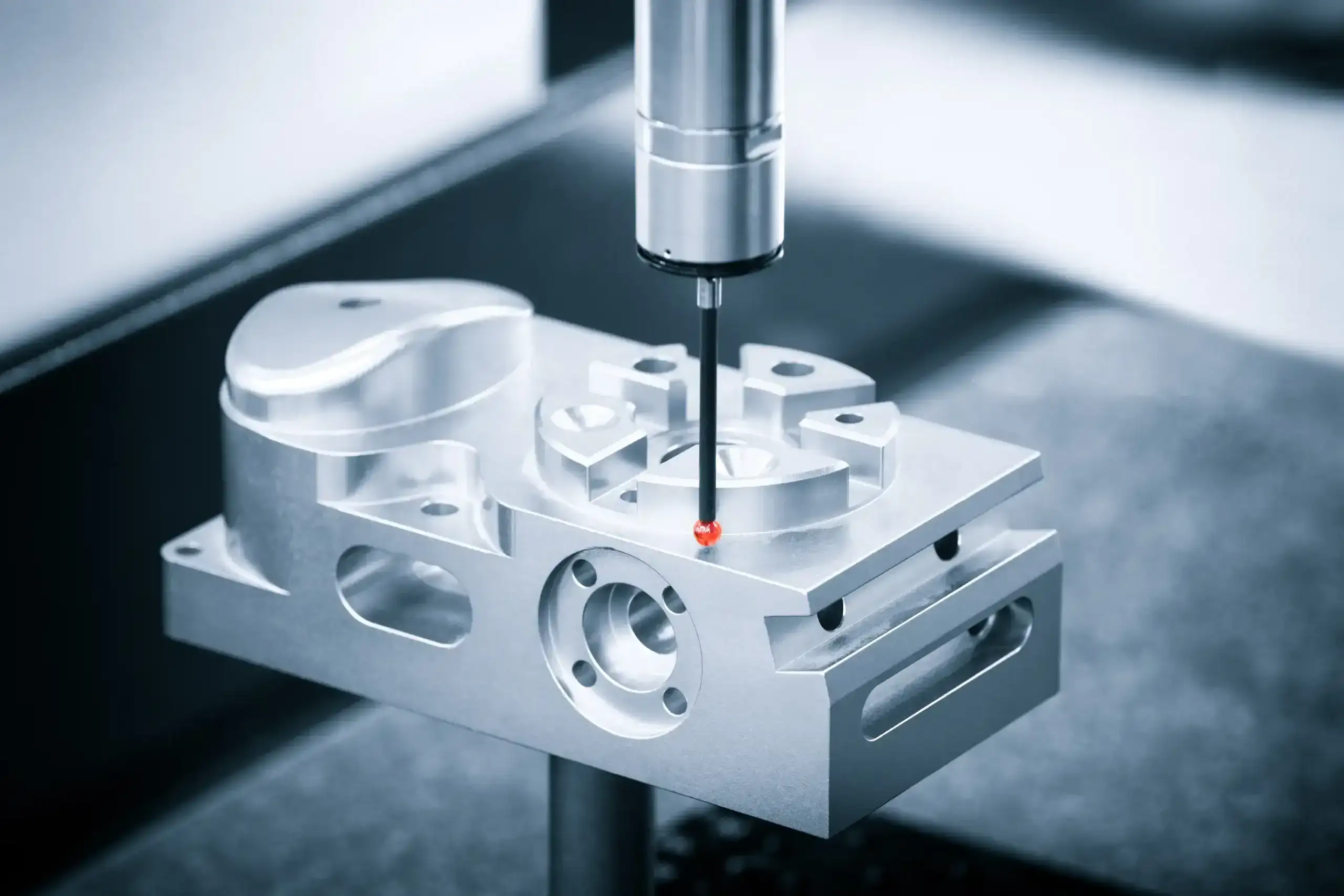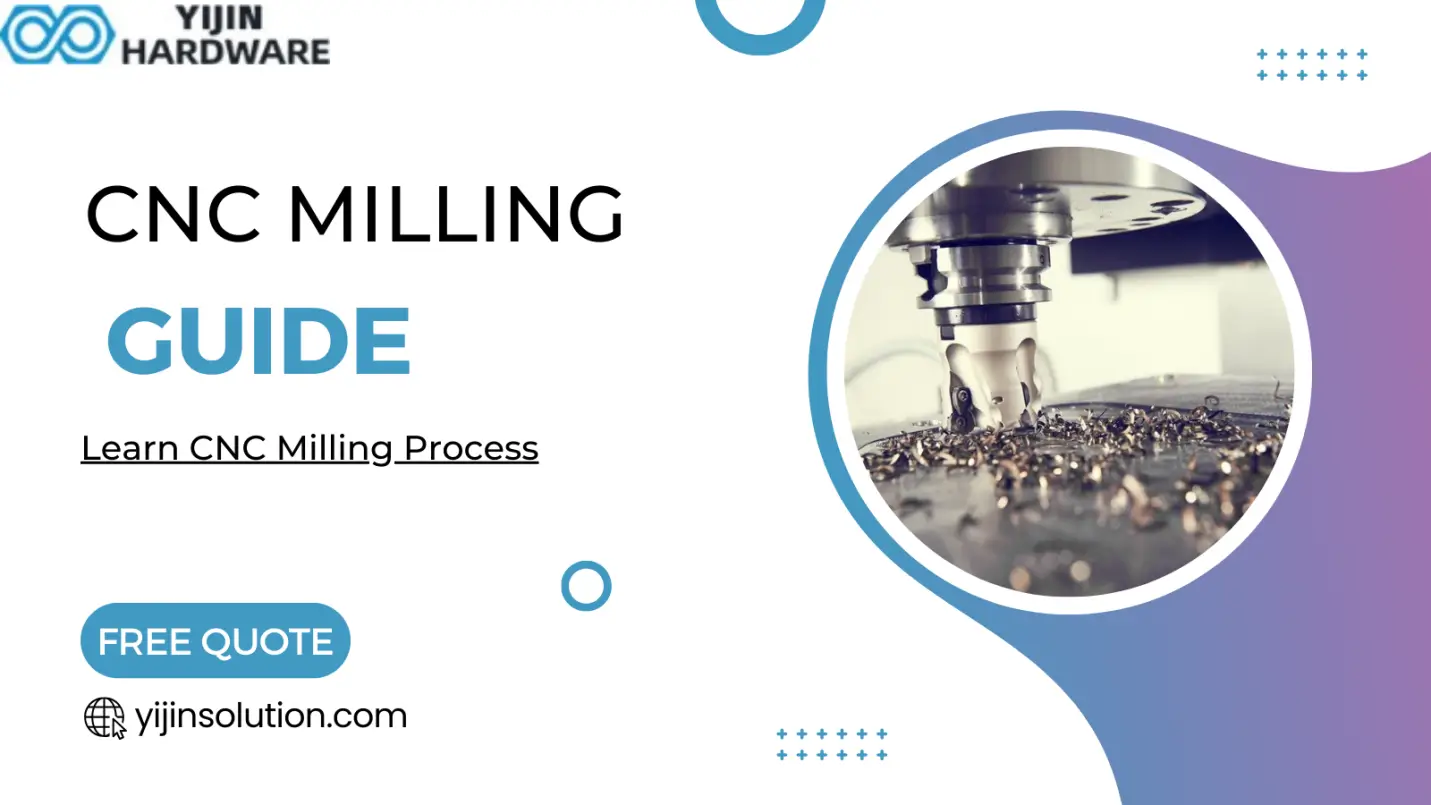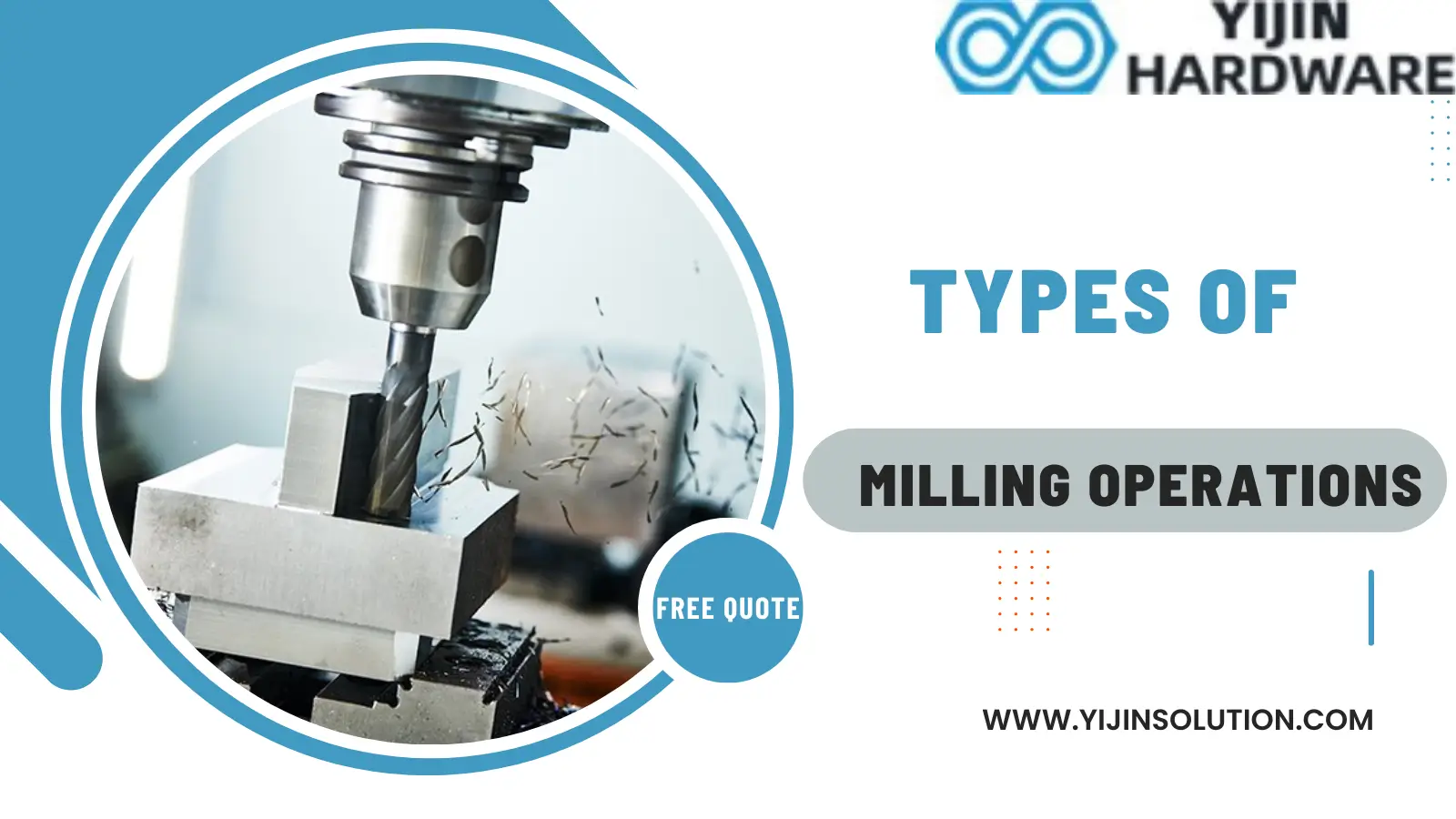In the world of materials, titanium is distinctive by its unique characteristics that present challenges and advantages in CNC machining. This article thoroughly explores the features of CNC machining titanium, elaborating on all that needs to be known about this tough but difficult-to-machine metal.
What will you learn?
The readers will gain an understanding of the accuracy needed in tool selection, the role of proper adjustments to control heat and avoid tool wear, and the use of titanium in crucial industries such as aerospace, medical, and automotive. To resolve the challenges of machining titanium and ensure efficiency and quality in production, practical tips and strategic insights are given.
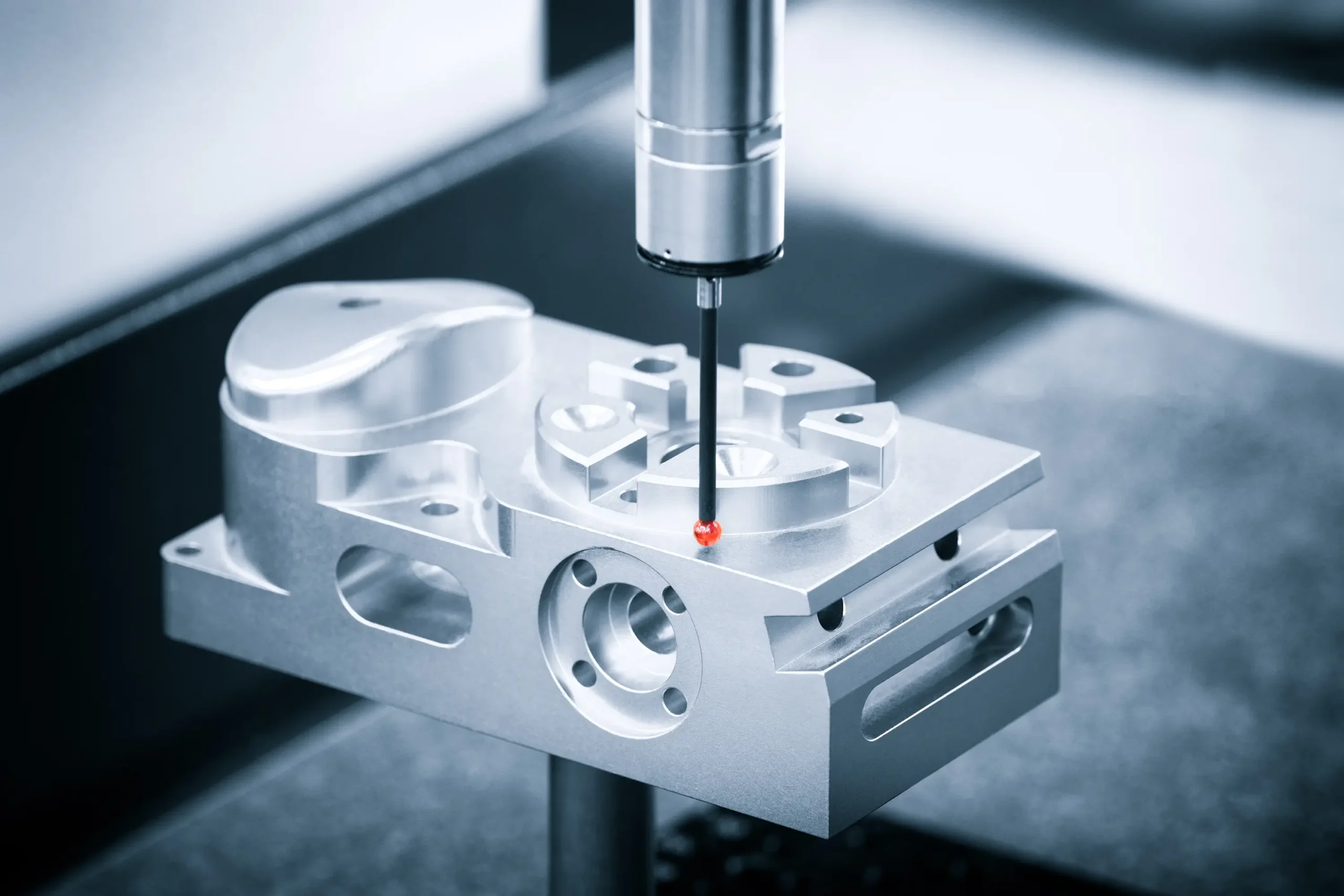
Overview of Titanium Machining
Titanium is noticeable in machining for its strength and low weight. Its weight is smaller than that of most metals, such as copper and stainless steel. The ratio of its strength to weight is also very good. This makes it suitable for aerospace, defence and medical equipment. The resistance of titanium to heat and corrosion is high compared to other heavy metals. It also fits well in biomedical uses due to its compatibility with human tissues.
Machining titanium presents unique challenges. It demands specific techniques and tools to manage its strength and hardness effectively. You need the right approach to machine titanium efficiently without stressing the tools or yourself. This knowledge will guide you to better understand and tackle titanium machining in your projects.
You May Like:
Titanium Machining Process
Machining titanium requires precision and the right tools due to its unique properties. Heat resistance and strength make it a challenging material. Here’s how you can handle it effectively:
- Choosing the Right Cutting Tool:
Opt for a coated high-speed steel tool. This tool also withstands with temperature of 600℃. It allows for deeper cuts with minimal shock to your workpiece. This reduces the chance of chipping.
- Applying Tool Coating:
Coatings are crucial for managing heat. Consider a titanium aluminium nitride (TiAlN) coating. It activates with heat, forming a protective layer that minimizes heat transfer. This keeps your tool sharp and effective.
- Ensuring a Stable Cutting Surface:
Titanium’s flexibility may cause vibrations, known as chattering. To avoid this, use a solid setup. Choose tools with a larger core diameter and minimal overhang from the spindle. Maintain steady feeds and speeds. Avoid slowing down in corners to reduce chatter and wear on your tool.
- Using Climb Milling:
Employ climb milling to manage chip formation. This method starts with thicker chips that thin out, pulling heat away from your workpiece. It ensures a cleaner cut and reduces tool wear.
These steps help you master titanium machining. They save your tools and improve your work quality. Stay consistent and watch your technique to avoid common pitfalls.
Tips for Titanium Machining
Machining titanium requires precision and careful planning. Here are straightforward tips to help you:
- Secure Your Parts Firmly:
Titanium can cause vibrations, known as tool chatter. Secure your parts well to reduce this. Use rigid CNC setups and shorter tools to prevent deflection.
- Choosing the Right Cutting Tools for Titanium Machining:
Implement the tools which are specially made for the titanium (like the tool treated with titanium carbo-nitride (TiCN) or titanium aluminium nitride (TiAlN)). These coatings enhance tool durability under high temperatures.
- Manage Cutting Parameters Wisely:
Control the temperature during machining. Use high-pressure coolants directed at the cut to prevent overheating. Adjust feed rates, spindle speeds, and chip loads to minimize stress on tools. Consider altering cutting strategies, like increasing axial cut depth while reducing radial engagement. This improves cutting efficiency and reduces heat.
- Use High-Pressure Cooling Systems:
For finishing work, keep the tool’s contact minimal and sharp. High-pressure cooling systems help remove heat efficiently, preserving tool life and maintaining precision.
These tips will help you improve your machining process as well as prolong the tool’s life. Adopting these strategies, you will overcome challenges associated with titanium and achieve good results.
You May Like:
Magenesium CNC Machining
Why Choose Titanium for CNC Machining
Choosing CNC machining for titanium is a smart decision. Here’s why:
- Superior Strength and Lightweight:Titanium tops other metals in strength-to-weight ratio. This quality makes it perfect for CNC machining titanium parts where robustness yet lightness is crucial.
- Highly Durable:Parts made from titanium stand up well under tough conditions. This durability suits CNC titanium machining for parts used in harsh environments.
- Corrosion Resistance:With its excellent resistance to corrosion, titanium is a prime choice for environments where rust and decay are concerns. This trait enhances the lifespan of CNC machined components.
- Biocompatibility:The non-toxic nature of titanium makes it safe for medical applications. Its compatibility with the human body is why titanium CNC machining is widely used in medical device manufacturing.
- Non-magnetic Property:Being non-magnetic, titanium is ideal for applications where magnetic interference is a problem. This feature is valuable in both aerospace and medical fields.
- Superb Oxidation Resistance:Titanium resists oxidation exceptionally well, protecting it from wear and degradation over time. This characteristic ensures the longevity and reliability of machined parts.
CNC machining is the best choice for accurate, reliable and cost-effective titanium parts.
Common Titanium Grades for Machining
In the case of choosing titanium for CNC machining, knowledge about the various grades is essential. Every grade possesses unique characteristics which make it suitable for certain applications:
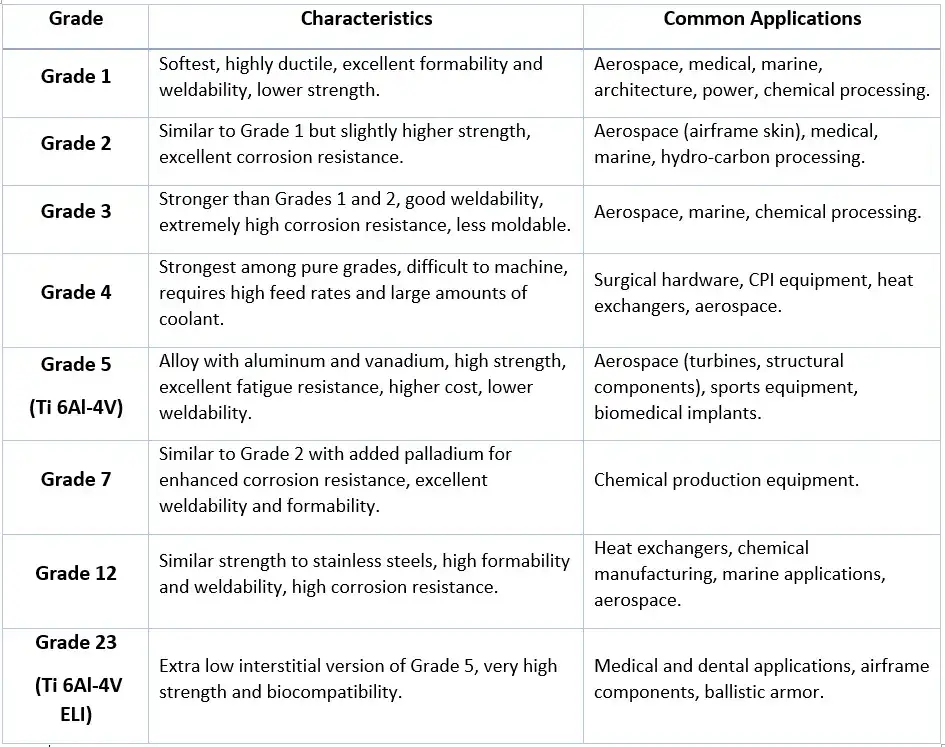
- Grade 1 Titanium:This is the softest, making it highly formable and ductile. It’s perfect for jobs needing high weldability, like in aerospace or medical industries.
- Grade 2 Titanium:A bit stronger than Grade 1, this grade is also very formable and widely used due to its affordability. Common selection for industrial uses where high strength and corrosion resistance are required.
- Grade 3 Titanium:Stronger and less moldable than the first two, Grade 3 is best for environments where corrosion resistance is critical, like in chemical processing or marine applications.
- Grade 4 Titanium:The strongest of the pure grades, Grade 4 is less formable but excels in medical and industrial settings due to its durability and weldability.
- Grade 5 (Ti 6Al-4V) Titanium:Known as the “workhorse” of the aerospace industry, this alloy handles high temperatures and is used in aircraft turbines and structural components. It is also important in sports equipment and biomedical implants.
- Grade 7 Titanium:Extremely corrosion-resistant, thanks to added palladium, making it ideal for chemical production equipment.
- Grade 12 Titanium:Similar in strength to stainless steels, this grade is versatile, with applications in heat exchangers and chemical manufacturing.
- Grade 23 (Ti 6Al-4V ELI) Titanium:Known for its strength and biocompatibility, Grade 23 is used in medical and dental applications, as well as airframe components and ballistic armour.
These grades have different advantages so, choose wisely according to the requirement of your project. Regardless of whether it is the formability of Grade 1 or the strength of Grade 5, the correct titanium grade makes your CNC titanium machining project better.
Surface Finishes for Titanium machining
CNC machining titanium allows for various surface finishes to enhance both functionality and appearance.
- Polishing:This process smooths the titanium’s surface, giving it a shiny, mirror-like finish. It’s great for parts that need aesthetic appeal.
- Anodizing:Anodizing titanium creates a corrosion-resistant layer and can add vibrant colors to the metal. This is useful for parts that require both durability and visual impact.
- Chroming:Chroming coats titanium parts with a thin layer of chromium, enhancing their durability and shine.
- Powder Coating:This technique involves applying a protective and decorative powder to the surface, which is then cured under heat. It’s excellent for adding robustness and color.
- PVD Coating:Physical Vapor Deposition (PVD) applies a thin film to the titanium that improves wear resistance and reduces friction.
- Brushing:Brushing creates a unidirectional satin finish, giving a workpiece a textured look while hiding fingerprints and light scratches.
These finishes can help your CNC titanium machining project to stand out, practically or aesthetically. Select the one that fits your project best.
Applications of Titanium Machined Parts
Titanium machined parts are used in different industries due to their durability, corrosion resistance and aesthetic properties.
Here’s how various sectors benefit from titanium:
- Medical and Dental:
Titanium is also useful in medical industry due to their strength and compatibility. These are used in fabricating bone screws for dental implants, spinal rods, which in turn may be used for orthopedic pins. Titanium is very popular due to the fact it is very accurate in the manufacture of these components and this is done by either wire CNC machining or milling.
- Marine and Naval:
Titanium, however, is best in marine environments because of its extra corrosion resistance. It is applied in the production of propeller shafts, underwater robotics, and marine heat exchangers. Titanium is particularly popular because these elements must resist harsh sea conditions.
- Automotive:
While aluminum is usually a cheaper alternative, titanium is used in high-performance automotive parts. This involves valves, suspension springs, and engine parts. The strength and the lightweight properties of titanium, however, make it suitable for advanced engineering applications.
- Aerospace:
Titanium is highly regarded for its strength-to-weight ratio and capability to function in high temperatures in aerospace industry. Turbine blades, seat frames, and oxygen system parts among other aircraft components are made of titanium parts. These applications are the recipients of the accuracy of titanium CNC machining which ensures safety and efficiency of the flight.
Each of these industries utilizes titanium’s unique properties, enhancing product performance and reliability through CNC titanium machining. This makes titanium a versatile and vital material in demanding engineering applications.
Also Read:
Aluminum CNC Machining
Challenges in Titanium CNC Machining
CNC machining titanium can be tricky due to its unique traits. Here are the main challenges:
- Heat Management:Titanium holds heat, causing high temperatures during machining. This can harm both the tool and the work piece. Using more coolant and tools with better coolant systems helps.
- Tool Wear and Galling:Titanium is tough and sticks to tools, wearing them out quickly. This issue can cause galling, where titanium clings to the tool and messes up the machining. Tools coated with TiAlN (titanium aluminium nitride) reduce this wear and make tools last longer.
- Elasticity and Work piece Deflection:Titanium is more flexible under stress. This flexibility can make the workpiece move away from the tool, harming accuracy. Strong work holding and correct cutting paths are key to keep things precise.
- Chip Control:Titanium creates long, stringy chips during cutting. These chips can scratch the workpiece or break the tool. Using tooling that makes smaller, thicker chips can improve this, making machining smoother and more efficient.
- Cost and Cutting Parameters:Titanium costs more than materials like steel. It needs a careful setting of cutting speeds and feed rates. This careful setting helps avoid too much wear on tools and damage to the workpiece.
These challenges mean you need to choose the right tools, set your machine correctly, and use the best methods to machine titanium well while keeping quality and efficiency.
Yijin Hardware: Your Premium Titanium Machining Partner
In conclusion, CNC machining titanium has many benefits for industries. These industries need precision, strength, and durability. But, there are challenges like managing heat and tool wear. Material elasticity also requires special handling. We need specific techniques and tools for these issues. Understanding these issues helps manufacturers use titanium better. This leads to high-quality, strong parts.
Choose Yijin Hardware as your titanium machining partners. They have advanced technology and lots of experience. With Yijin Hardware, your projects will meet the highest standards of precision and quality. Contact us today.
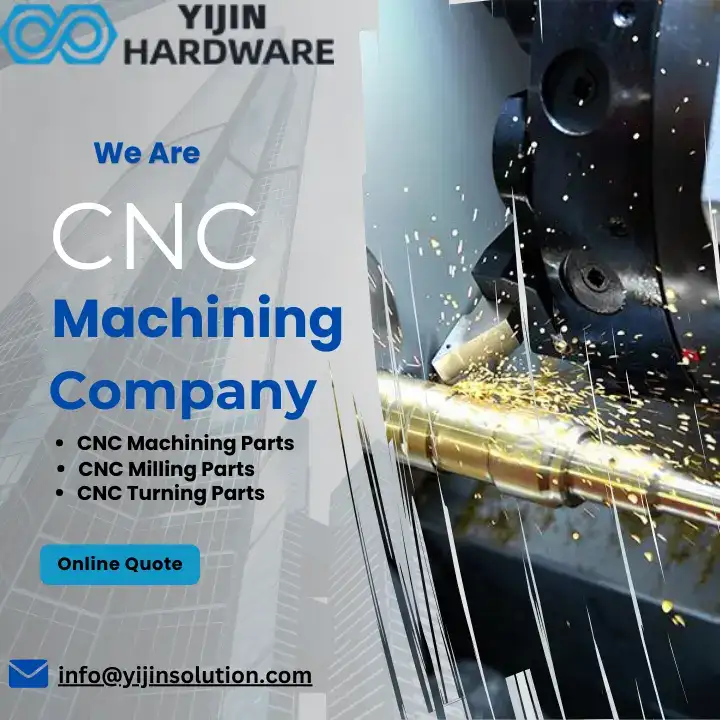
FAQs:
How does titanium compare to other metals in CNC machining?
Titanium outperforms many metals with its durability and strength-to-weight ratio. However, it is more challenging to machine due to its properties.
How do you improve CNC machining of titanium?
Use specific cutting tools, apply correct machining techniques, and optimize cutting parameters to manage heat and ensure precision.
What are the best practices for cutting titanium in CNC machining?
It’s crucial to use high-feed mills, ensure minimal radial and axial engagement, and apply coatings like Titanium Aluminum Nitride to the tools. This approach helps manage the heat and prevent tool wear.
 Call Us Today! (+86) 188-2253-7569
Call Us Today! (+86) 188-2253-7569